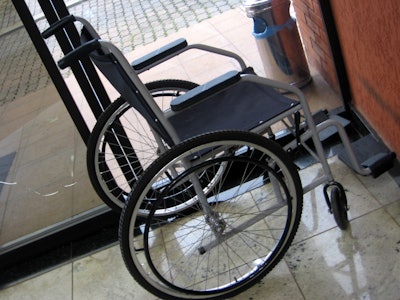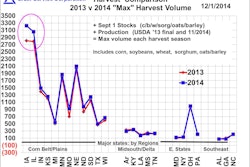
We often take for granted just how dangerous a job it is to be an agricultural worker, particularly one that makes his living working in and around feed bins. But the sobering fact is, at least according to a Purdue University study on grain bin accidents, a typical year in the United States produces 35 grain-entrapment accidents with the majority being fatal.
There are no two ways about it; the agricultural industry can be a dangerous place for workers who must constantly navigate quicksand-like grain, while at the same time keeping in their peripheral vision mechanisms that chop, cut, grind, roll and crush. The harsh environment got the better of Josh Blankenship, a bin worker in Advance, MO, a few years ago when he and a co-worker were busy cleaning an emptied grain bin. A sweep auger was in use and tragically, Blankenship stepped back and his left leg went into the hole in the bin floor. The auger chewed into his upper leg, severed his femur, and tore through bone, muscle, nerves and tissue. His foot was nearly severed. Through the quick work of medical personnel, his leg was saved, but required five subsequent surgeries over a two-week period, including extensive reconstruction involving bone, nerves and muscle reattachments.
Blankenship is only one of the many employees in this industry who have been injured on the job and collecting corkers’ compensation. And because of this, insurance premiums are skyrocketing and impacting employers throughout the region. But there is no need to wave the white flag with one hand and pull out the checkbook with the other. There are ways employers in agricultural businesses can start to control their costs.
Missteps to avoid
In one case, a large feed company with more than 100 employees working in various locations across three Midwestern states is paying over $600,000 in workers’ compensation premiums because circumstances have driven its experience mod up to a hefty 2.0. Now, to the average person a 2 doesn’t sound like a big number. But in the often complex world of workers’ compensation, a 2 is a very large and expensive number.
The head of the company thought he had the situation under control. He had three safety managers on duty, realtionships with clinics to interview the injured workers, a return-to-work program, and all the steps he felt he needed to keep his experience mod at the industry average of 1.0. But there were missteps along the way.
First, the three safety managers he designated had no industry safety experience and didn’t fully grasp the concept of workers’ compensation. Second, the clinics he associated himself with had no experience handling injuries typical of the agricultural industry, and had not even visited the plants to see the potential dangers there. And third, his return-to-work program was simply this: When you are better, come back to work. Instead of setting up a program of transitional work to ease workers back into their current jobs, they were allowed to sit at home watching daytime TV with a steady stream of lawyers telling them they should sue their employer (“Have you been injured on the job? … We can get you the money you deserve!”).
But the worst of it is that the company is in desperate need, as most companies are, of a culture change — one that eliminates the saying “accidents will happen” because this tells employees that saying eventually they will get injured on the job, and it’s no big deal. The truth is, a culture change needs to come from the top, by instilling in workers the notion that injuries are preventable and shouldn’t be considered the norm.
Lower your experience mod
So how does a company like this solve its glaring problems? First and foremost, they should start with managing both their on-site injuries and their experience mod. Employee injuries and the experience mod go hand in hand, directly impacting both their profit and loss and the cost of their workers’ compensation insurance.
Let’s illustrate how expenses for employee injuries drive up the experience mod, guaranteeing the insurance company gets their money back. A feed manufacturer in Missouri completed an experience mod worksheet listing each employee injury and the injury’s actual cost to the company. One employee injury where the insurance company paid out $897 ended up costing the employer an additional $2,150 because of the impact on their experience mod. For another injury, the insurance company paid $1,999 in medical bills and lost wages. However, the employer paid back $4,800 in increased premiums because of this $1,999 the insurance company paid.
So, how can business owners manage employee injuries to avoid this financial nightmare? Many states, including Missouri, Illinois, Kansas and Iowa, have in place what is called an experience rating adjustment. This adjustment allows a 70% reduction on the cost of the employee injury, if the employee comes back to work before the insurance company makes a payment to them for lost wages (known as an indemnity payment). With this rule, if the insurance company pays for lost time, all medical expenses as well as the total cost of wages, hit the employer’s Experience Mod. If no lost time wages are paid, then the medical expenses that do hit the mod are reduced by 70%.
Rely on physicals
Many problems can be alleviated before they happen by making sure you don’t hire a workers’ compensation claim waiting to happen. And this all starts with the pre-employment physical — the only way to truly determine if a person can do the job you are offering. It’s important to develop a post-offer physical and medical questionnaire. This will tell the employer not only if the applicant can do the job offered, but if they get hurt on the job the employer also has a good idea of how to get them back to work quickly.
For example, if an employee gets a rotator cuff injury and has been on physical therapy for a year and is not getting better, there is a high probability he didn’t have 100% use before he was hired. The way to find this out is by setting up relationships with clinics versed in occupational medicine, that understand the workers’ compensation system, to screen incoming employees and also suggest transitional jobs to get them back to work as soon as possible.
Transitional duty plans
Should an employee pass his pre-employment due diligence and still get injured on the job, it’s important to have a plan in place for transitional duty. This can be any type of work that’s meaningful to the employee. As an employer, you cannot bring injured workers back to work and have them “do nothing.” The transitional duty does not have to be on the premises. For instance, the injured employee can train at home by watching safety videos, or they can come to the office and answer the phone and file paperwork. The end game is to have that worker do meaningful work and prevent the insurance company from paying the indemnity payment.
As for getting employees to return to work as soon as possible, each state has different rules on how long an injured employee can be out of work before lost wages kick in. In some states, lost wages begin after the injured employee is out of work for seven consecutive days, while in other states it’s three consecutive days. A few states have other waiting periods.
However, many employers believe if they have to bring an injured employee back on alternate or transitional duty, they don’t get the full benefit. So the mind-set is to send the injured worker home and let the insurance company pay. In reality it’s the company’s money paying the medical bills and lost wages, not the insurance company’s.
It’s important to remember that the experience mod is the heart of each employer’s workers’ compensation program. Think of it as the employer’s injury report card. Employers often feel that because their experience mod is 1.0 they are in good shape, but on that injury report card, that means they are a C, or “just average.” Certainly they should strive to be more than that.
This leads full circle back to the feed company previously mentioned, sitting on a 2.0 experience mod and $600,000 in premiums. By implementing all the different facets touched upon, it is not unrealistic to think that within two years their mod will drop to a 1, and after four years even as low as .72, with a total savings of over $380,000. The savings alone are certainly enough incentive to be more vigilant about job safety and to have a transitional plan in place for injured workers to return to the job as soon as physically possible should an accident happen.

















